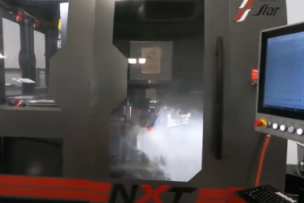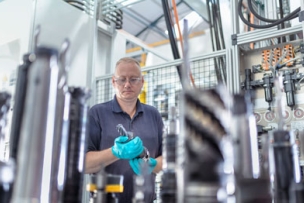Get an experienced machinist’s guidance on how to amp up 5-axis productivity with the right workholding, tooling and proactive setup and simulation.
Some shops give short shrift to their workholding when purchasing their first 5-axis machining center. With all the excitement that comes with a move into 5-axis simultaneous milling, it’s an easy place to overlook, but doing so might mean missing out on all the performance and output the new machine has to offer.
Without the right vise or fixture, for example, setups could be more difficult: Less of the part will be accessible, leading to additional operations downstream and potential quality problems. Toolholder interference can become more of a concern—and it might mean a very expensive crash.
Having the correct vise or fixture type is also true for a rotary-trunnion table on a 3-axis vertical machining center—or when using a 5-axis machine for basic 3+2 work. Either way, the workpiece must be sufficiently elevated to eliminate any chance of interference between the machine table and the spindle housing or toolholders.
The solution? Put your 6-inch machinist’s vise away in favor of true 5-axis workholding. Here is a primer on how to properly select an effective vise or fixture for your 5-axis needs—and several other key insights in setup, simulation and toolholding balance.
Self-Centering Vise vs. Single Acting Vise: What’s Right For You?
Do you need a single-acting vise, or one that’s self-centering? As the name implies, the latter centers the work within the vise and is helpful when performing a secondary operation, where positioning in relation to an existing feature is critical. However, if you're only performing first operations on your 5-axis machine and will always finish the part elsewhere, either vise will work perfectly well.
The Need to Cut (or Purchase) Dovetails for Gripping
Many 5-axis vises require that you pre-machine the part blank by cutting a dovetail for gripping and possibly a slot or hole on the locating end of the blank, both of which are machined away afterward. This will probably mean sawing the blanks oversize by ⅛ of an inch or so and allowing for extra time to prepare the blanks, important considerations when quoting the job.
Don’t want to mess with dovetails? Check with your material supplier, as some are now offering dovetailed blanks for their 5-axis customers. Yes, you’ll pay for this service, but it might be more cost-effective to skip blank preparation and focus your energy on doing what you do best: making parts.
The Value of Pyramid Vises
Because you’re usually cutting the top and sides of the workpiece (which is the whole point of 5-axis machining in the first place) you are often limited to a single part per cycle. Since cycle times are typically longer because you’re doing more operations per part handling, this isn’t as big of a problem as you might initially think. Still, you might prefer to load up the machine and come back a couple of hours later.
You’re in luck: A number of tooling manufacturers offer pyramid-style vises that accommodate three, four or more parts on a single fixture.
A Full Range of Workholding Solutions and “Quick Change” Options
Be aware that a number of other workholding choices exist, including the ability to: grip parts internally, use riser blocks for additional clearance, employ serrated and step jaws, use double-sided or micro vises, as well as rely on quick-change mechanisms. The quick-change option is an important one—if your shop hasn’t made the move to zero-point or ball lock-style positioning, now might be the time. Given the investment, you’ll want to help minimize and prioritize setup time to help take full advantage of your 5-axis machine.
The Value of Auto-Tuning, Anti-Collision and Probing Packages
There’s plenty more to the 5-axis story: The type of machine and the available options supporting 5-axis work require careful research. Some builders provide “auto-tuning” capabilities, designed to reduce geometric errors, and anti-collision functions to eliminate the chance of a bad day. Also, probing packages are a big help in determining work coordinate systems during setup, something that can be confusing to those new to 5-axis machining (and experienced machinists).
For those still shopping for a 5-axis, be aware of the various machine configurations that are available. Some builders take a trunnion-rotary approach to drive the A and B axes, while others use a swivel-rotate mechanism. What about horizontal vs. vertical? The pros and cons of each are every bit as applicable here. And let’s not forget that a 5-axis-capable turn-mill or multitasking machine might be in your future, which is another animal entirely. Whatever the case, be sure to partner with a company that understands 5-axis machining and can help you get the most out of your investment.
The Value of Machine Simulation: How CAD/CAM Can Help
Looking for other setup options? There is another way to reduce setup time: toolpath simulation software. A number of excellent packages exist, most of which will interface cleanly with your CAM system. All are a big helping hand on any machine tool, but especially so on one with five (or more) axes, where machine motions are generally complex and tool clearances often challenging.
Simulating the toolpath in the CAD/CAM office eliminates surprises during setup. It provides programmers a chance to optimize everything about the setup, from minimizing tool lengths to reducing wasted motion to checking for gouging or interference. It also lets the setup people know what to expect, making them more confident of the results. Granted, implementing such a system takes some effort upfront modeling fixtures and toolholders, but most of these are readily available for download. Simply put, if you’re not simulating, you’re wasting time and creating risk.
“The type of machine and the available options supporting 5-axis work require careful research. Some builders provide “auto-tuning” capabilities, designed to reduce geometric errors, and anti-collision functions to eliminate the chance of a bad day.”
Do Not Forget About the Value of Balanced Toolholding Assemblies
Last but not least is toolholding. Just as the vise must be elevated in most 5-axis setups, so too must the end mills and drills be made to reach farther. Thankfully, there’s no shortage of long-reach tooling: The trick is to invest in the right ones and then use them correctly. How is that done? You can start with balancing.
You might not be spinning your tools at 20,000 rpm, so perhaps you think balanced toolholders (or more properly, balanced toolholder assemblies) are unnecessary. That would be incorrect, especially when it comes to the long-reach holders common with 5-axis machining, where any runout or imbalance is magnified exponentially.
So even if you’re only running at a few thousand rpm, it’s a darned good idea to balance. And do so as a complete assembly, with the cutting tool, toolholder and retention knob (if applicable) included. While you’re at it, take that and the tool offsets offline by investing in a good presetter. Together with your shiny new 5-axis machining center, you’ll soon be cranking out parts like you never have before.
Are you getting the most out of your 5-axis machine? Share your challenges.




Talk to Us!
Thank you for giving an overview of how to set up a 5-axis machine. My son is interested in mechanical engineering and I imagine this will be an article of interest to him. I will definitely share this post with him when he gets back home later. https://americancnc.net/
28Leave a reply
Your email address will not be published. Required fields are marked *